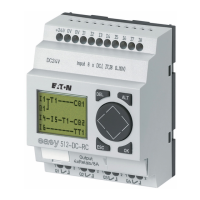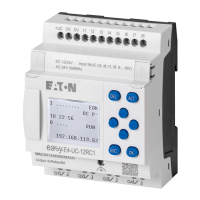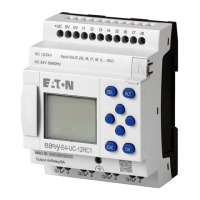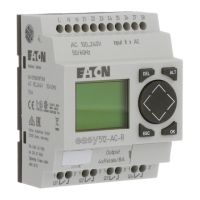9. easyE4 inside
9.7 NET network
Station 4 sending a network marker [bit and word] to all stations.
NET-ID4 NET-ID 2
NET-ID 5
NET-ID 7
N 125
→
4 N 125
4 N 125
4 N 125
NW30
→
4 NW 30
4 NW 30
4 NW 30
This basic principle applies to all network markers in all data formats:
Network markers overlap in the various data formats
N1-8
N9-
16
N17-
24
N25-
32
N33-
40
N41-
48
N49-
56
N57-
64
NB1
NB2
NB3
NB4
NB5
NB6
NB7
NB8
NW1 NW2 NW3 NW4
ND1 ND2
N65-
72
N73-
80
N81-
88
N89-
96
N97-
104
N105-
112
N113-
120
N121-
128
NB9
NB10
NB11
NB12
NB13
NB14
NB15
NB16
NW5 NW6 NW7 NW8
ND3 ND4
etc.
Life signs NET stations
In order to make it possible for all NET stations within a group to be able to know
whether NET stations important to them are still communicating, each station cyclically
sends a heartbeat every second (1 s). If a heartbeat is not received, the corresponding
error bit ID01 – 08 will be set to "1" until a heartbeat is detected.
Remote Run
If this flag is set, the NET stations in a group with NET-ID 02 through 08 will follow the
current operating mode of the NET station with NET-ID 1 (RUN or STOP).
Bus Delay
The bus delay defines the delay that a station on the NET will use when sending its data
to other stations.
This bus delay must be adjusted in line with the number of stations and the values being
transmitted. If it is too short, there will be data collisions and the Ethernet will be limited
to transmitting NET communications exclusively.
The value range for the bus delay is 10 ms to 255 ms.
The following rule of thumb applies:
l Case A: When using PUT/GET and network markers:
l Bus delay in ms = (number of NET stations - 1) * 4 * 2 + 6
l Case B: If only network markers are being used:
l Bus delay in ms = (number of NET stations - 1) * 2 * 2 + 6
514
easyE4 11/18 MN050009 EN www.eaton.com
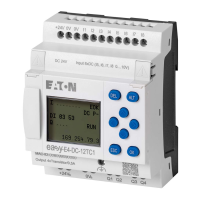
